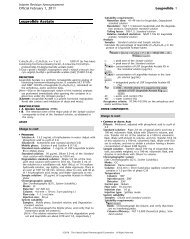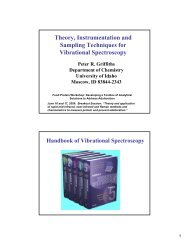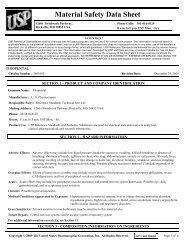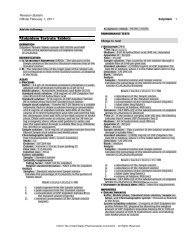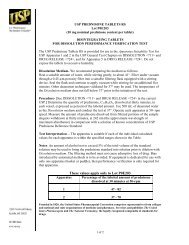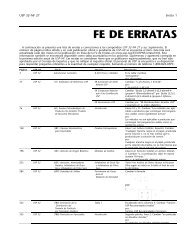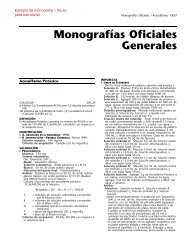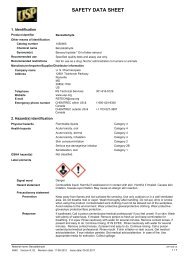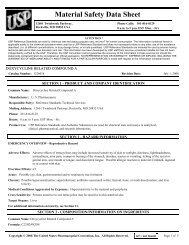Powdered Valerian - US Pharmacopeial Convention
Powdered Valerian - US Pharmacopeial Convention
Powdered Valerian - US Pharmacopeial Convention
You also want an ePaper? Increase the reach of your titles
YUMPU automatically turns print PDFs into web optimized ePapers that Google loves.
. ivatization<br />
Revision Bulletin<br />
Official December 1, 2013 <strong>Valerian</strong> 1<br />
reagent B, heat at 100° for 3 min, and<br />
<strong>Powdered</strong> <strong>Valerian</strong><br />
examine under white light.<br />
Acceptance criteria: After treatment with Derivatization<br />
DEFINITION<br />
reagent A and heating, the Sample solution does<br />
not exhibit an intense blue band at about the middle<br />
Change to read:<br />
of the chromatogram nor any other significant bands<br />
[distinction from Mexican valerian (<strong>Valerian</strong>a edulis)],<br />
though minor bands may be observed.<br />
<strong>Powdered</strong> <strong>Valerian</strong> is <strong>Valerian</strong> reduced to a fine or a very<br />
After treatment with Derivatization reagent B and heatfine<br />
powder. It contains no calcium oxalate crystals and<br />
ing, the Sample solution exhibits three violet bands in<br />
no foreign starch granules. It contains NLT 0.3% of vola- positions and colors similar to the bands of Standard<br />
tile oil, NLT 0.04% of valerenic acid (C 15H 22O 2), ■ .and NLT solution B. These bands include a minor band in the<br />
0.1% of total valerenic acids, calculated as the sum of lower third of the chromatogram due to hydroxhydroxyvalerenic<br />
acid, acetoxyvalerenic acid, and valer-<br />
yvalerenic acid, a major band at about the middle the<br />
enic acid, on the dried basis. ■1S (<strong>US</strong>P36)<br />
chromatogram due to acetoxyvalerenic acid [distinction<br />
IDENTIFICATION<br />
from Scouler’s valerian (<strong>Valerian</strong>a wallichii)], and a<br />
major band at an R F corresponding to the valerenic<br />
Change to read:<br />
acid band of Standard solution A and Standard solution<br />
B. Other minor bands may be observed in the Sample<br />
• A. ■.Meets the requirements for Specific Tests, Botanic<br />
solution and in Standard solution B. ■1S (<strong>US</strong>P36)<br />
Characteristics ■1S (<strong>US</strong>P36)<br />
Add the following:<br />
Change to read:<br />
■<br />
.• D. HPLC<br />
Analysis: Proceed as directed in the test for Content of<br />
Valerenic Acids.<br />
Acceptance criteria: The Sample solution exhibits a<br />
peak at a retention time corresponding to the valerenic<br />
acid peak of Standard solution A. The Sample solution<br />
shows additional peaks corresponding to hydroxyvaler-<br />
enic acid and acetoxyvalerenic acid. ■1S (<strong>US</strong>P36)<br />
• B.<br />
■<br />
.Sample solution: 0.2 g of <strong>Powdered</strong> <strong>Valerian</strong> in 5 mL<br />
of methylene chloride. Shake several times, and allow<br />
to stand for 5 min. Filter, wash the filter with 2 mL of<br />
methylene chloride, combine the filtrate and washings,<br />
and evaporate to dryness. Dissolve the residue in<br />
0.2 mL of methylene chloride.<br />
Analysis: To 0.1 mL of the Sample solution add 3 mL of COMPOSITION<br />
a mixture of equal volumes of glacial acetic acid and<br />
25% hydrochloric acid, and shake several times. Change to read:<br />
Acceptance criteria: A blue color develops within 15<br />
min. ■1S (<strong>US</strong>P36)<br />
Add the following:<br />
■<br />
.• C. THIN-LAYER CHROMATOGRAPHY<br />
• CONTENT OF VALERENIC ■ .ACIDS ■1S (<strong>US</strong>P36)<br />
■<br />
.Solution A: Mix 6 mL of 85% phosphoric acid with<br />
900 mL of water, dilute with water to 1000 mL, mix,<br />
filter, and degas.<br />
Solution B: Mix 6 mL of 85% phosphoric acid with<br />
900 mL of methanol, dilute with methanol to 1000 mL,<br />
mix, filter, and degas.<br />
Standard solution A: 0.25 mg/mL of <strong>US</strong>P Valerenic<br />
Acid RS in methanol<br />
Standard solution B: 40 mg/mL of <strong>US</strong>P <strong>Powdered</strong> Va- Mobile phase: See Table 1.<br />
lerian Extract RS in methanol. Sonicate for 10 min,<br />
centrifuge, and use the supernatant.<br />
Sample solution: About 0.5 g of <strong>Powdered</strong> <strong>Valerian</strong> in<br />
Table 1<br />
5 mL of methanol. Sonicate for 10 min, centrifuge, and Time Solution A Solution B<br />
use the supernatant. (min) (%) (%)<br />
Chromatographic system 0 40 60<br />
Adsorbent: Chromatographic silica gel mixture with<br />
an average particle size of 2–10 µm (HPTLC plates)<br />
Application volume: 5 µL, as 8-mm bands<br />
Developing solvent system: A mixture of cyclohexane,<br />
ethyl acetate, and acetic acid (60:38:2)<br />
Derivatization reagent A: A mixture of glacial acetic<br />
acid and hydrochloric acid (1:4)<br />
Derivatization reagent B: 0.5 mL of p-anisaldehyde,<br />
10 mL of acetic acid, and 5 mL of sulfuric acid. Add to<br />
85 mL of ice-cold methanol, and mix.<br />
Analysis<br />
Samples: Standard solution A, Standard solution B, and<br />
Sample solution<br />
Apply the Samples as bands to a suitable high-perfor-<br />
mance thin-layer chromatographic plate. Use a saturated<br />
chamber, and condition the plate to a relative<br />
humidity of about 33% using a suitable device. Develop<br />
the chromatograms over a distance of 6 cm.<br />
Remove the plate from the chamber, dry, derivatize<br />
with Derivatization reagent A, heat at 120° for 5 min,<br />
and examine under white light. Derivatize with Der-<br />
15 5 95<br />
25 5 95<br />
30 40 60<br />
Solvent: A mixture of methanol and a solution of 0.1%<br />
phosphoric acid in water (3:1)<br />
Standard solution A: 0.02 mg/mL of <strong>US</strong>P Valerenic<br />
Acid RS in methanol. Sonicate if necessary.<br />
Standard solution B: Sonicate a portion of <strong>US</strong>P <strong>Powdered</strong><br />
<strong>Valerian</strong> Extract RS in Solvent to obtain a solution<br />
having a concentration of about 20 mg/mL. Before injection,<br />
pass through a membrane filter of 0.45-µm or<br />
finer pore size, discarding the first few mL of the<br />
filtrate.<br />
Sample solution: To a 50-mL volumetric flask, transfer<br />
about 1.0 g of <strong>Powdered</strong> <strong>Valerian</strong>, accurately weighed,<br />
add 10.0 mL of water, and shake for 2 min while heat-<br />
ing in a water bath maintaned at about 50°. Sonicate<br />
for 15 min, add 35 mL of methanol, and sonicate for<br />
15 min. Cool, dilute with methanol to volume, and<br />
mix. Before injection, pass through a membrane filter<br />
©2013 The United States <strong>Pharmacopeial</strong> <strong>Convention</strong> All Rights Reserved.
Revision Bulletin<br />
2 <strong>Valerian</strong> Official December 1, 2013<br />
of 0.45-µm or finer pore size, discarding the first few Sample: 100 g of <strong>Powdered</strong> <strong>Valerian</strong><br />
mL of the filtrate. Acceptance criteria: NLT 0.3%<br />
Chromatographic system<br />
(See Chromatography 〈621〉, System Suitability.)<br />
CONTAMINANTS<br />
Mode: LC<br />
Detector: UV 225 nm<br />
Delete the following:<br />
Column: 4.6-mm × 25-cm; end-capped, 5-µm 100 Å<br />
packing L1<br />
•.• HEAVY METALS 〈231〉: 50 µg/g<br />
Column temperature: 40°<br />
•.• (RB 1-Dec-2013) • (RB 1-Dec-2013)<br />
Flow rate: 1.0 mL/min<br />
Injection volume: 25 µL<br />
Change to read:<br />
System suitability<br />
Samples: Standard solution A and Standard solution B •.• ELEMENTAL IMPURITIES—PROCEDURES 〈233〉<br />
Suitability requirements<br />
Acceptance criteria<br />
Chromatogram similarity: The chromatogram of<br />
Arsenic: NMT 0.5 µg/g<br />
Standard solution B is similar to the reference chro-<br />
Cadmium: NMT 1.0 µg/g<br />
matogram provided with the lot of <strong>US</strong>P <strong>Powdered</strong><br />
Lead: NMT 5.0 µg/g<br />
<strong>Valerian</strong> Extract RS being used.<br />
Mercury: NMT 0.1 µg/g• (RB 1-Dec-2013)<br />
Tailing factor: NMT 2.0 for the valerenic acid peak, •.• (RB 1-Dec-2013)<br />
Standard solution A<br />
• ARTICLES OF BOTANICAL ORIGIN, General Method for Pesti-<br />
Relative standard deviation: NMT 2.0% for the<br />
cide Residues Analysis 〈561〉: Meets the requirements<br />
valerenic acid peak in repeated injections, Standard<br />
• MICROBIAL ENUMERATION TESTS 〈2021〉: The total bactesolution<br />
A<br />
rial count does not exceed 10 cfu/g, the total com-<br />
Analysis<br />
5. bined molds and yeasts count does not exceed 10 cfu/<br />
Samples: Standard solution A, Standard solution B, and<br />
3. g, and bile-tolerant Gram-negative bacteria does not ex-<br />
Sample solution<br />
ceed 10 cfu/g.<br />
Identify the valerenic acids in the Sample solution chro-<br />
3. • ABSENCE OF SPECIFIED MICROORGANISMS 〈2022〉: It meets<br />
matogram by comparison with the chromatograms of<br />
the requirements of the tests for absence of Salmonella<br />
Standard solution A, Standard solution B, and the referspecies<br />
and Escherichia coli.<br />
ence chromatogram provided with the lot of <strong>US</strong>P<br />
<strong>Powdered</strong> <strong>Valerian</strong> Extract RS being used.<br />
SPECIFIC TESTS<br />
Calculate the percentages of hydroxyvalerenic acid,<br />
acetoxyvalerenic acid, and valerenic acid in the por- Change to read:<br />
tion of <strong>Powdered</strong> <strong>Valerian</strong> taken:<br />
• BOTANIC CHARACTERISTICS<br />
Result = (r U/r S) × C S × (V/W) × F × 100<br />
Microscopic: ■ .Numerous starch granules, simple, hilum<br />
dotted, stellate or cleft-shaped, 5–15 µm in diamer<br />
U = peak area of the relevant analyte from the<br />
ter; compound starch granules of 2–6 components;<br />
Sample solution<br />
black, cruciate shape under a polarizing microscope.<br />
r S = peak area of valerenic acid from Standard<br />
Scattered stone cells, single or aggregated, with cell<br />
solution A<br />
lumina of various sizes, bright yellowish-white or bright<br />
C S = concentration of valerenic acid in Standard<br />
white under a polarizing microscope; numerous fragsolution<br />
A (mg/mL)<br />
ments of parenchyma cells containing globules of vola-<br />
V = volume of the Sample solution (mL)<br />
tile oil and starch granules; fragments of pale yellow<br />
W = weight of <strong>Powdered</strong> <strong>Valerian</strong> taken to prepare<br />
lignified fibers, scattered, single or aggregated; fragthe<br />
Sample solution (mg)<br />
ments of vessels, reticulate, bordered pitted and spiral.<br />
F = conversion factor for each analyte (1.10 for<br />
■1S (<strong>US</strong>P36)<br />
hydroxyvalerenic acid, 1.25 for<br />
acetoxyvalerenic acid, and 1.00 for valerenic<br />
Delete the following:<br />
acid)<br />
Acceptance criteria: NLT 0.04% of valerenic acid<br />
■<br />
.• ARTICLES OF BOTANICAL ORIGIN, Foreign Organic Matter<br />
(C 15H 22O 2), and NLT 0.1% of total valerenic acids, cal-<br />
〈561〉: NMT 2.0% culated as the sum of hydroxyvalerenic acid, acetox-<br />
■1S (<strong>US</strong>P36)<br />
• EXTRACTABLE MATTER<br />
yvalerenic acid, and valerenic acid on the dried<br />
Sample: 2 g of <strong>Powdered</strong> <strong>Valerian</strong>, carefully dried at<br />
basis ■1S (<strong>US</strong>P36) 40°<br />
• ARTICLES OF BOTANICAL ORIGIN, Volatile Oil Determination<br />
Analysis: Mix the Sample with 20 mL of 70% alcohol,<br />
〈561〉<br />
and allow to stand for 2 h, shaking frequently. Filter,<br />
evaporate 5 mL of the filtrate on a water bath to dryness,<br />
and dry the residue at 105°.<br />
Acceptance criteria: NLT 20%<br />
Delete the following:<br />
■<br />
.• WATER, Method 1a 〈921〉: NMT 5.0% ■1S (<strong>US</strong>P36)<br />
©2013 The United States <strong>Pharmacopeial</strong> <strong>Convention</strong> All Rights Reserved.
Revision Bulletin<br />
Official December 1, 2013 <strong>Valerian</strong> 3<br />
Add the following:<br />
• LABELING: The label states the Latin binomial and, following<br />
the official name, the parts of the plant from<br />
■<br />
.• LOSS ON DRYING 〈731〉<br />
which the article was derived.<br />
Sample: 1.0 g of <strong>Powdered</strong> <strong>Valerian</strong><br />
Analysis: Dry at 105° for 2 h.<br />
Change to read:<br />
Acceptance criteria: NMT 12% ■1S (<strong>US</strong>P36)<br />
• ARTICLES OF BOTANICAL ORIGIN, Total Ash 〈561〉: NMT • <strong>US</strong>P REFERENCE STANDARDS 〈11〉<br />
12.0% ■.<strong>US</strong>P <strong>Powdered</strong> <strong>Valerian</strong> Extract RS ■1S (<strong>US</strong>P36)<br />
• ARTICLES OF BOTANICAL ORIGIN, Acid-Insoluble Ash 〈561〉: <strong>US</strong>P Valerenic Acid RS<br />
NMT 5.0%<br />
ADDITIONAL REQUIREMENTS<br />
• PACKAGING AND STORAGE: Preserve in well-closed containers,<br />
store at room temperature, and protect from<br />
light and moisture.<br />
©2013 The United States <strong>Pharmacopeial</strong> <strong>Convention</strong> All Rights Reserved.




